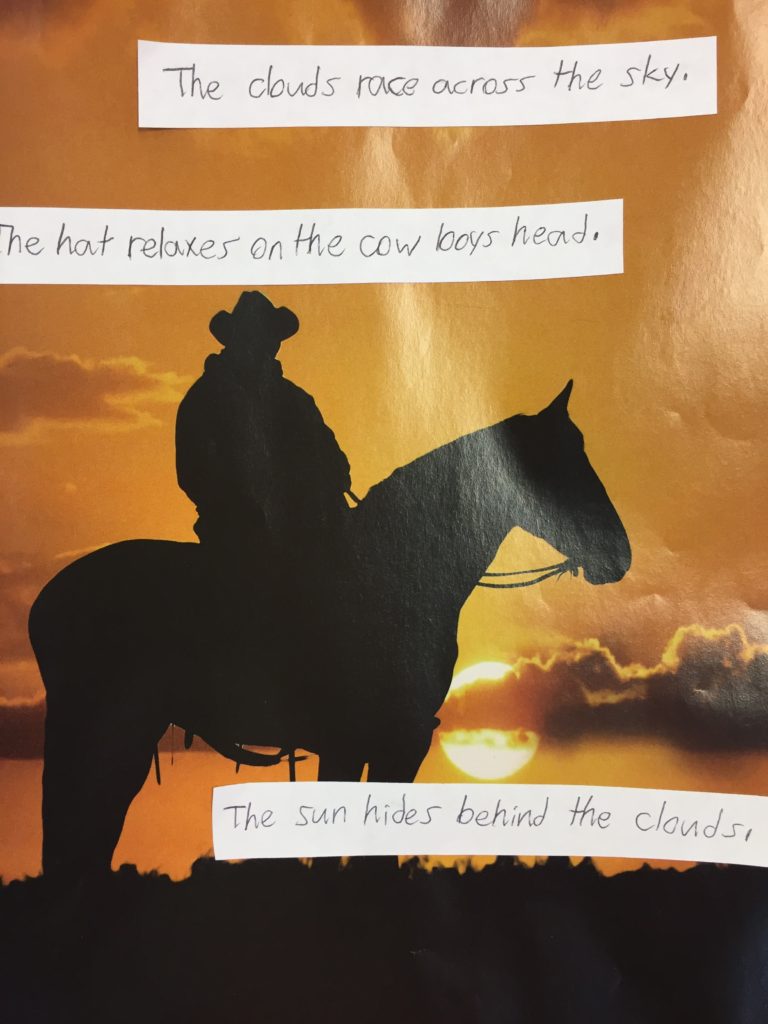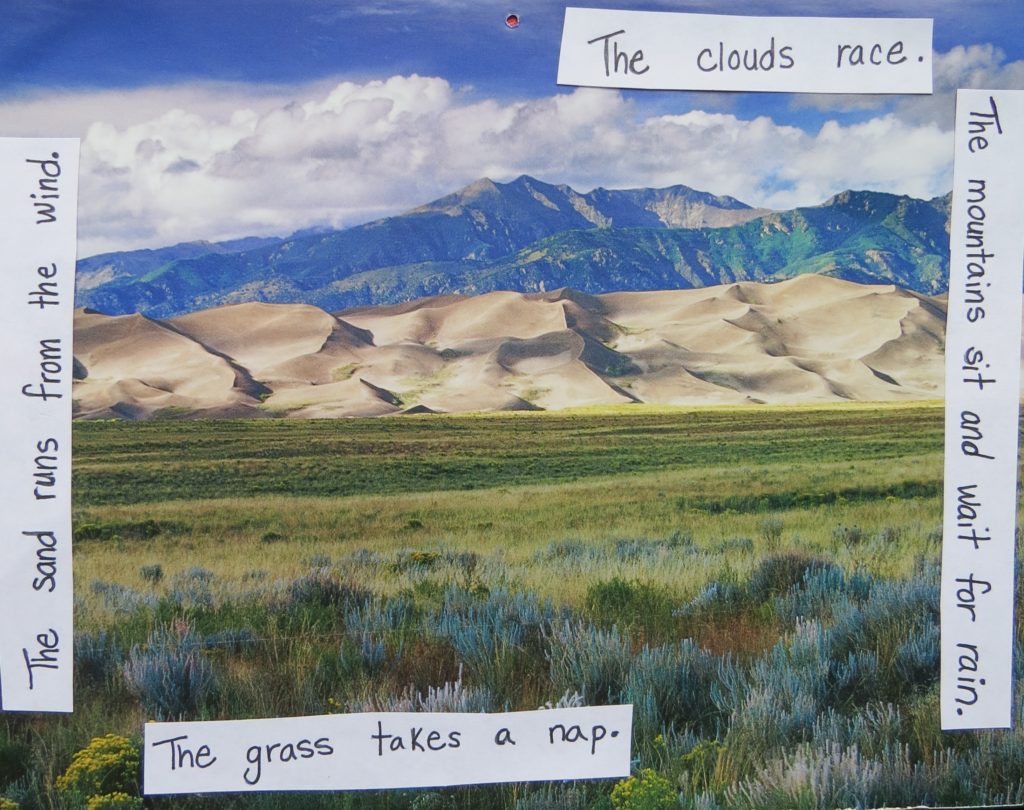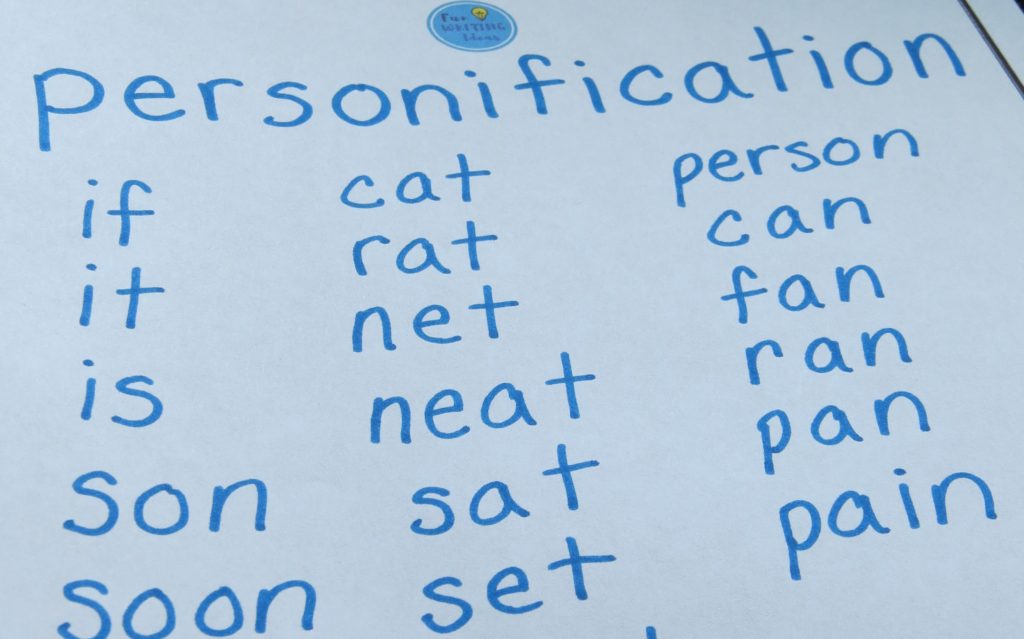Writing personification can be tricky for young writers, but once they learn it, they really enjoy it! This post includes four activities that involve students writing personification!
*This post contains affiliate links. For more information, see my disclosures here.*
Why Write With Personification?
Learning how to write with personification is good for two reasons:
- First, it helps students find personification in written text.
- Second, it enhances their ability to write descriptively, especially scenery
Calendar Pictures

Moreover, this personification lesson goes best with scenic pictures from old calendar pictures. My students OFTEN use calendar pages to inspire or accompany their writing. Find 19 Writing Activities to Use With Calendar Pictures here!
NOW THE LESSON!
What is personification?
- Teach the students that personification is when a noun (a thing) does a human action. Here are some short examples:
“The sun woke up.”
“The wind whistled.”
Here are some longer examples:
“The sun greeted everyone with a bright smile.”
“The leaves danced across the lawn.”
“The flowers waved to all those passing by.”
“The door waited for someone to open it.”
The Final Product
2. Next, explain to the students that they are going to choose a scenic picture from the stack of calendar pages.
3. Then, show them that they are going to write statements of personification on strips of white paper.
4. Lastly, explain that they will glue the white pieces of paper on or around the border of their picture like this:

NOW TO WRITE!
Guide the students to complete the following steps.
Choose a Picture
- Choose a calendar page.
Brainstorm Nouns
2. On a white scratch piece of paper, write down nouns that you see in the picture.
For example, in the following image, you might write the nouns: sky, clouds, mountains, sand, dunes, grass, flowers, weeds, wind

3. Choose 2-4 nouns that you want to write about. (Younger children may only be able to write one sentence. Older students can write 4.)
Write what the noun does.
4. Write a sentence that tells what the noun is doing. The noun has to do a human action.
The clouds race. The mountains sit and wait for rain.
5. Have an adult check the sentences to make sure they are personification.
6. Rewrite the sentences neatly on thin white strips of paper.
7. Glue the strips of paper to the calendar page, preferably around the border so the picture can still be seen.

8. Place the finished piece in a plastic page protector*.
Students can write personification for more than one calendar page if they want to.
Writing with personification isn’t easy, but once students catch on, they love it!
Print the Lesson
3 GAMES TO PLAY!
1. Personification Statements
Personification Statements is a great game to help students practice writing personification.
What is Personification?
Before you begin, remind the students that personification is when a noun (a thing) does a human action.
For example: The mountains shout hello.
*This post contains affiliate links. For more information, see my disclosures here.*
SETTING UP THE GAME:
You’ll need two magnetic spinners*.

(If you haven’t read my full post on the winner spinner you won’t want to miss it! It gives you a long list of game ideas that are so easy to run and super fun for the kids. Check out the full post here.)
- Draw two circles on the whiteboard or chalkboard.
- Divide the first circle into 8 or 16 sections (8 for younger, 16 for older)
- Have students tell you 8 or 16 nouns to fill the sections. The nouns can be ANYTHING.
- Fill the second circle with the numbers 4-11.
Smaller Groups
5. For smaller groups (up to 8) divide a large classroom whiteboard into 4 sections. Assign a pair to each section.

Larger Groups
6. For larger groups, or if you don’t have a classroom whiteboard, give each pair a small white board, dry erase marker and a sock to serve as an eraser.
Here’s a class pack you can purchase and use*.



NOW TO PLAY!
- First, two students spin for the whole group.
2. Second, one partner in each pair takes a turn writing a personification statement using the spun word and using the spun number of words to form the sentence.
For example, if the students spin the word stuffed animals and the #7 :

They might write:

Normal or Silly!
The personification statements can be normal or super silly!
In order for the sentence to be counted personification, the noun has to be doing a human action.
Earning Points
3. In order to earn a point, the sentence has to have a capital letter, spacing, correct spelling and a period at the end.
4. Once students have completed their sentence, they don’t say anything. They just hold up their white board.
5. Look at it. If there is one mistake, hold up 1 finger. If there are 2 mistakes, 2 fingers, 3 mistakes, 3 fingers, 4 mistakes, 4 fingers. When there are no mistakes, students get a thumbs up and tally a point.
6. When students have a mistake, they continue to correct the sentence until you give them a thumbs up.
7. Students who get a thumbs up right away can continue to write more sentences, earning more points while they wait for every student to finish their one sentence.
8. Once each pair has correctly written the sentence, move onto the next turn.
9. Continue play until each pair has had a turn to spin or until the allotted time runs out!
Print the Instructions
Here are the instructions for you to print and use.
2. How Many Words using the word PERSONIFICATION

3. Personification Races
Turn anything into a race and kids are ready to play! Personification races are great for reviewing and practicing personification. Like Acrostic and Onomatopoeia Races, personification races are really easy to conduct and play.
In addition, this game helps students strengthen their ability to write descriptively.
SETTING UP THE GAME
This game does not require the winner spinner so you can literally play it any time and any where.
Smaller Groups
1. For smaller groups (up to 8), divide the board into 4 sections. Assign a pair to each section.

Larger Groups
2. If you’re working with larger groups, divide the group into pairs. Give each pair a small white board, dry erase marker and a sock to serve as an eraser. You can purchase a class pack on Amazon*.



Mixed Ages and Abilities
3. When working with groups of mixed ages and abilities, pair the students older or advanced with younger or struggling. Older students take a turn together. Then, the younger students take a turn.
NOW TO PLAY!
- First, call out a noun that is a thing and write it on the whiteboard.
- Second, the students race to write a personification statement. In the sentence, the noun has to do a human action.
Examples
Sample words and sentences include:
Sun: The sun fell asleep.
Snow: Snow hugged the mountain tops.
Grass: The grass cringed every time a shoe stepped on it.
Here are more words you can use: Leaves, wind, rain, sand, cacti, clouds, sky, moon, flowers, water, mountains, lighthouse, pumpkin pie, race car, lightning, waterfall, rocket, oreo cookie, shoes etc.
Earning Points
3. In order to earn a point, the sentences have to have a capital letter, spacing, correct spelling and a period at the end.
4. Once they’ve completed their sentence, students don’t say anything. They just hold up their white board.

5. Look at it. If there is one mistake, hold up 1 finger. If there are 2 mistakes, 2 fingers, 3 mistakes, 3 fingers, 4 mistakes, 4 fingers. When there are no mistakes, students get a thumbs up and tally a point.
6. Students who have a mistake continue to correct the sentence until you give them a thumbs up.
7. Students who get a thumbs up right away can continue to write more sentences, earning more points while they wait for every student to finish their one sentence.
8. Once each pair has correctly written the sentence, move onto the next turn.
9. Continue play until your allotted time runs out!
Print the Instructions
Here are the instructions for you to print and use.Download
For a more challenging game of personification, you can play Personification Statements 4-11.
Both games go great with the writing prompt titled, Writing With Personification.

